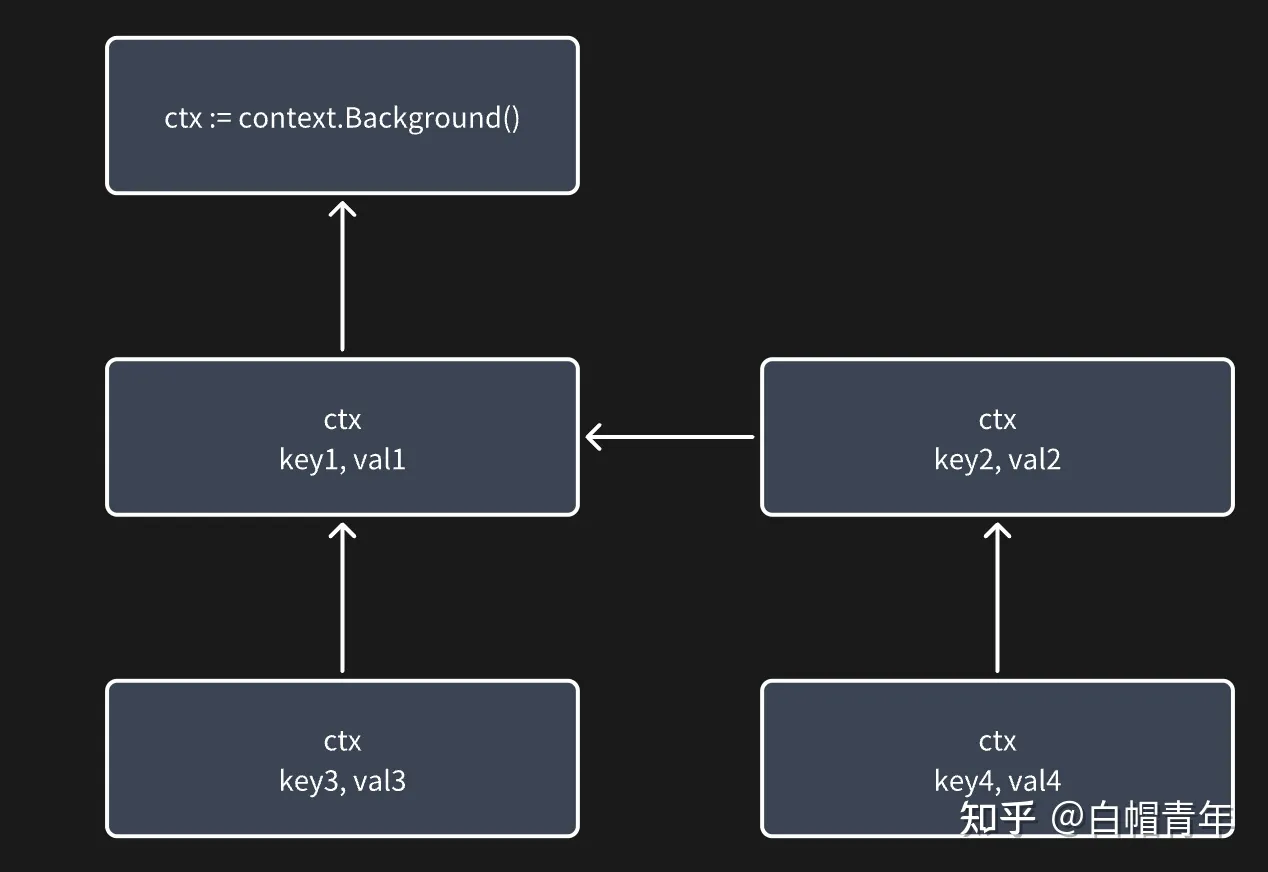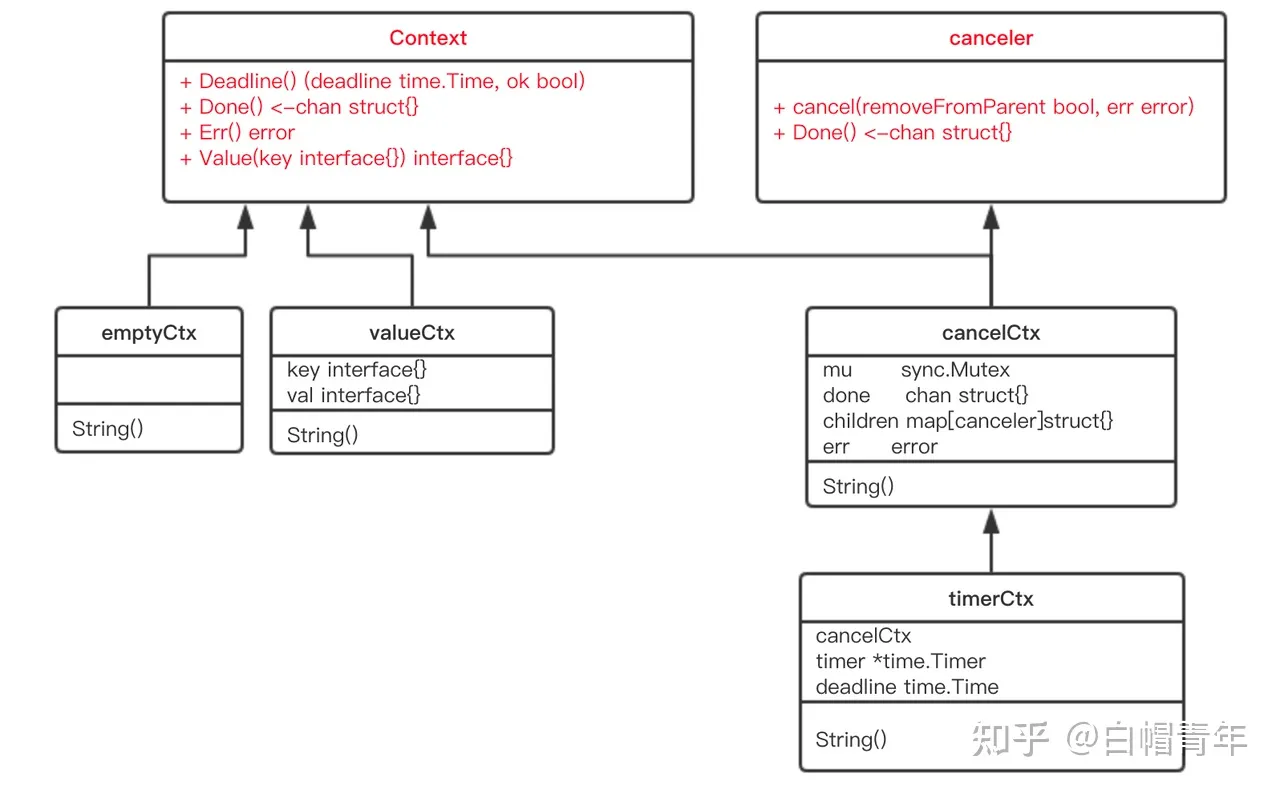本文最后更新于:2023年12月10日 晚上
1、作用
context 主要用来在 goroutine 之间传递上下文信息,包括:取消信号、超时时间、截止时间、k-v 等,
context的数据结构一棵倒排树,具体会在下文源码走读中剖析。
2、代码结构
context包的核心是context interface,及实现了context接口的emptyCtx、valueCtx、cancelCtx、timerCtx。
2.1、Context interface
Context 是一个接口,定义了 4 个方法,它们都是幂等的。也就是说连续多次调用同一个方法,得到的结果都是相同的。
type Context interface {
// 返回一个 channel,可以表示 context 被取消的信号:当这个 channel 被关闭时,
// 说明 context 被取消了。注意,这是一个只读的channel,读一个关闭的 channel 会读出相应类型的零值。
// 并且源码里没有地方会向这个 channel 里面塞入值。换句话说,这是一个 receive-only 的 channel。
// 因此在子协程里读这个 channel,除非被关闭,否则读不出来任何东西。
// 也正是利用了这一点,子协程从 channel 里读出了值(零值)后,就可以做一些收尾工作,尽快退出。
Done() <-chan struct{}
// 在 channel Done 关闭后,返回 context 取消原因
Err() error
// 返回 context 是否会被取消以及自动取消时间(即 deadline)
Deadline() (deadline time.Time, ok bool)
// 获取 key 对应的 value
Value(key interface{}) interface{}
}2.2、emptyCtx
type emptyCtx int
func (*emptyCtx) Deadline() (deadline time.Time, ok bool) {
return
}
func (*emptyCtx) Done() <-chan struct{} {
return nil
}
func (*emptyCtx) Err() error {
return nil
}
func (*emptyCtx) Value(key any) any {
return
}- emptyCtx 是一个空的 context,类型为一个整型;
- Deadline 方法会返回一个公元元年时间以及 false 的 flag,标识当前 context 不存在过期时间;
- Done 方法返回一个 nil 值,用户无论往 nil 中写入或者读取数据,均会陷入阻塞;
- Err 方法返回的错误为 nil;
- Value 方法返回的 value 为 nil.
2.2.1、Background & TODO
var (
background = new(emptyCtx)
todo = new(emptyCtx)
)
func Background() Context {
return background
}
func TODO() Context {
return todo
}Background 和TODO是一个空的 context, context.Background() 和 context.TODO() 方法返回的均是 emptyCtx 类型的一个实例。
2.3、context.WithValue() & valueCtx
context.WithValue() 用于基于传入的ctx作为parent ctx构造一个valueCtx
func WithValue(parent Context, key, val any) Context {
if parent == nil {
panic("cannot create context from nil parent")
}
if key == nil {
panic("nil key")
}
if !reflectlite.TypeOf(key).Comparable() {
panic("key is not comparable")
}
return &valueCtx{parent, key, val}
}
// A valueCtx carries a key-value pair. It implements Value for that key and
// delegates all other calls to the embedded Context.
type valueCtx struct {
Context
key, val any
}valueCtx继承了Context interface,并实现了Stringer 接口
从源码的value方法,可以发现context取值的查找方向是往上走的,且一般最终会找到的父ctx是emptyCtx,并调用emptyCtx的Value方法返回nil。所以,父节点没法获取子节点存储的值,子节点却可以获取父节点的值。
// 直接打印ctx 出现的.WithValue前缀,就是因为valueCtx重写了stringer接口
func (c *valueCtx) String() string {
return contextName(c.Context) + ".WithValue(type " +
reflectlite.TypeOf(c.key).String() +
", val " + stringify(c.val) + ")"
}
func (c *valueCtx) Value(key any) any {
// 假如当前 valueCtx 的 key 等于用户传入的 key,则直接返回其 value;
if c.key == key {
return c.val
}
// 否则从 parent context 中依次向上寻找
return value(c.Context, key)
}
func value(c Context, key any) any {
for {
switch ctx := c.(type) {
// valueCtx 正常递归向上查找
case *valueCtx:
if key == ctx.key {
return ctx.val
}
c = ctx.Context
// cancelCtx timerCtx 则需要先判断key是否是cancelCtxKey
// 用于cancel的内部机制
case *cancelCtx:
if key == &cancelCtxKey {
return c
}
c = ctx.Context
case *timerCtx:
if key == &cancelCtxKey {
return &ctx.cancelCtx
}
c = ctx.Context
case *emptyCtx:
return nil
default:
return c.Value(key)
}
}
}2.4、context.WithCancel & cancelCtx
withCancel 方法返回了一个cancelCtx 和一个cancel闭包函数
func WithCancel(parent Context) (ctx Context, cancel CancelFunc) {
if parent == nil {
panic("cannot create context from nil parent")
}
c := newCancelCtx(parent)
propagateCancel(parent, &c)
return &c, func() { c.cancel(true, Canceled) }
}
// newCancelCtx returns an initialized cancelCtx.
func newCancelCtx(parent Context) cancelCtx {
return cancelCtx{Context: parent}
}2.4.1、cancelCtx
先看cancelCtx ,同样继承了Context 接口,并实现了canceler 接口
type cancelCtx struct {
Context
mu sync.Mutex // protects following fields
done atomic.Value // 实际类型为 chan struct{},即用以反映 cancelCtx 生命周期的通道;
children map[canceler]struct{} // 指向 cancelCtx 的所有子 context,子ctx只需要实现Done和cancel方法,因此重新定义了canceler接口,方便管理;
err error // set to non-nil by the first cancel call
}
type canceler interface {
cancel(removeFromParent bool, err error)
Done() <-chan struct{}
}2.4.2、cancelCtx.Done()
返回的是无缓冲区只读channel,用于配合select监听该ctx 的取消信号
func (c *cancelCtx) Done() <-chan struct{} {
// 基于 atomic 包,读取 cancelCtx 中的 chan;倘若已存在,则直接返回;
d := c.done.Load()
if d != nil {
return d.(chan struct{})
}
// 上锁
c.mu.Lock()
defer c.mu.Unlock()
// 再次判断 chan是否创建(double check)
d = c.done.Load()
if d == nil {
// 创建并返回chan(懒汉式,只有调用Done方法才会实际创建该channel)
d = make(chan struct{})
c.done.Store(d)
}
return d.(chan struct{})
}2.4.3、cancelCtx.cancel()
// closedchan is a reusable closed channel.
var closedchan = make(chan struct{})
func init() {
close(closedchan)
}
func (c *cancelCtx) cancel(removeFromParent bool, err error) {
// 必须要传 err
if err == nil {
panic("context: internal error: missing cancel error")
}
c.mu.Lock()
if c.err != nil {
c.mu.Unlock()
return // already canceled
}
c.err = err
// 处理 cancelCtx 的 channel,若 channel 此前未初始化,则直接注入一个 closedChan,
// 否则关闭该 channel;
d, _ := c.done.Load().(chan struct{})
if d == nil {
c.done.Store(closedchan)
} else {
close(d)
}
// 循环调用所用子ctx的cancel方法,通知取消
for child := range c.children {
// NOTE: acquiring the child's lock while holding parent's lock.
child.cancel(false, err)
}
// 移除child ctx
c.children = nil
c.mu.Unlock()
// 判断是否需要将自身从父ctx的children map中删除
if removeFromParent {
removeChild(c.Context, c)
}
}
func removeChild(parent Context, child canceler) {
// 如果 parent 不是 cancelCtx,直接返回(因为只有 cancelCtx 才有 children set)
p, ok := parentCancelCtx(parent)
if !ok {
return
}
p.mu.Lock()
if p.children != nil {
// 从 parent 的 children set 中删除对应 child
delete(p.children, child)
}
p.mu.Unlock()
}2.4.4、WithCancel()
var Canceled = errors.New("context canceled")
type CancelFunc func()
func WithCancel(parent Context) (ctx Context, cancel CancelFunc) {
// 校验父 context 非空;
if parent == nil {
panic("cannot create context from nil parent")
}
// 注入父 context 构造好一个新的 cancelCtx;
c := newCancelCtx(parent)
// 在 propagateCancel 方法内启动一个守护协程,以保证父 context 终止时,该 cancelCtx 也会被终止;、
// 因为父ctx不一定是cancelCtx
propagateCancel(parent, &c)
// 将 cancelCtx 返回,连带返回一个用以终止该 cancelCtx 的闭包函数
return &c, func() { c.cancel(true, Canceled) }
}2.4.5、propagateCancel()
传递父子 context 之间的 cancel 事件
// propagateCancel arranges for child to be canceled when parent is.
func propagateCancel(parent Context, child canceler) {
done := parent.Done()
if done == nil {
return // parent is never canceled(不可取消类型)
}
select {
case <-done: // 从parent 的done channel中尝试读数据,如果未取消,goroutine会阻塞在这
// parent is already canceled
child.cancel(false, parent.Err())
return
default:
}
if p, ok := parentCancelCtx(parent); ok { // parentCtx是cancelCtx类型
p.mu.Lock()
if p.err != nil {
// parent has already been canceled
child.cancel(false, p.err)
} else {
// 将自身注册进parent的children中,依靠parent的cancel机制取消
if p.children == nil {
p.children = make(map[canceler]struct{})
}
p.children[child] = struct{}{}
}
p.mu.Unlock()
} else {
// parent是用户实现的canceler 接口,额外启动一个goroutine去处理该ctx的取消回收
// 非必要情况避免自己实现canceler,会有额外的goroutine开销
atomic.AddInt32(&goroutines, +1)
go func() {
select {
case <-parent.Done(): // parent退出,透传parent err 并cancel child
child.cancel(false, parent.Err())
case <-child.Done(): // 自身被cancel时,可以退出该goroutine,避免内存泄露
}
}()
}
}2.4.6、parentCancelCtx()
向上获取一个最近的cancelCtx
func parentCancelCtx(parent Context) (*cancelCtx, bool) {
done := parent.Done()
// parent 的 channel 已关闭或者是不会被 cancel 的类型,则返回 false
if done == closedchan || done == nil {
return nil, false
}
// 若以特定的 cancelCtxKey 从 parent 中取值,取得的 value 是 parent 本身,则返回 true.
//(基于 cancelCtxKey 为 key 取值时返回 cancelCtx 自身,是 cancelCtx 特有的协议)
// 作用是向上追溯到一个最近的cancelCtx,将child添加到它的children map中,
// 从而少启动一个goroutine协程
p, ok := parent.Value(&cancelCtxKey).(*cancelCtx)
if !ok {
return nil, false
}
pdone, _ := p.done.Load().(chan struct{})
if pdone != done {
return nil, false
}
return p, true
}
var cancelCtxKey int
func (c *cancelCtx) Value(key any) any {
if key == &cancelCtxKey { // cancelCtxKey的指针 可以作为特殊标识符,因为它不会被外部修改
return c
}
return value(c.Context, key)
}关于cancel函数的 removeFromParent参数,分两种情况:
1、在context包内部 propagateCancel 调用时,传入为false,因为该方法是由parent cancel而发起的,children 只需负责将自身和自身的ctx取消即可,不需要再重复的将自身从parent中的children map中删除,否则会有同时遍历和删除一个 map 的问题
2、在WithCancel 返回的闭包cancel方法中,传入的是true。因为自身cancel,需要把自己从parent children map中移除(parent还未cancel)
2.5、timeCtx & context.WithTimeout & context.WithDeadline
timerCtx 基于 cancelCtx,只是多了一个 time.Timer 和一个 deadline。Timer 会在 deadline 到来时,自动取消 context。
type timerCtx struct {
cancelCtx
timer *time.Timer // Under cancelCtx.mu.
deadline time.Time
}2.5.1、timerCtx.Deadline()
仅timerCtx实现了Deadline,返回过期时间
func (c *timerCtx) Deadline() (deadline time.Time, ok bool) {
return c.deadline, true
}2.5.2、timerCtx.cancel()
func (c *timerCtx) cancel(removeFromParent bool, err error) {
// 复用继承的 cancelCtx 的 cancel 能力,进行 cancel 处理;
c.cancelCtx.cancel(false, err)
if removeFromParent {
// 从父节点中删除子节点
removeChild(c.cancelCtx.Context, c)
}
c.mu.Lock()
if c.timer != nil {
// 关掉定时器,这样在deadline 到来时,不会再次取消
c.timer.Stop()
c.timer = nil
}
c.mu.Unlock()
}2.5.3、context.WithTimeout & context.WithDeadline
func WithTimeout(parent Context, timeout time.Duration) (Context, CancelFunc) {
return WithDeadline(parent, time.Now().Add(timeout))
}
// Before reports whether the time instant t is before u.
func (t Time) Before(u Time) bool {
if t.wall&u.wall&hasMonotonic != 0 {
return t.ext < u.ext
}
ts := t.sec()
us := u.sec()
return ts < us || ts == us && t.nsec() < u.nsec()
}
func WithDeadline(parent Context, d time.Time) (Context, CancelFunc) {
if parent == nil {
panic("cannot create context from nil parent")
}
if cur, ok := parent.Deadline(); ok && cur.Before(d) {
// 如果parent的deadline早于本ctx指定的deadline时间,则直接构造一个cancelCtx
// 当parent超时时,直接调用cancel取消本ctx,不必在校验本ctx的超时逻辑
// The current deadline is already sooner than the new one.
return WithCancel(parent)
}
c := &timerCtx{
cancelCtx: newCancelCtx(parent),
deadline: d,
}
// 传递cancel事件,并注册进parent的children map
propagateCancel(parent, c)
dur := time.Until(d)
if dur <= 0 {
// 已经到期,取消ctx,err为DeadlineExceeded
c.cancel(true, DeadlineExceeded) // deadline has already passed
return c, func() { c.cancel(false, Canceled) }
}
c.mu.Lock()
defer c.mu.Unlock()
if c.err == nil {
// c.timer 会在 d 时间间隔后,自动调用 cancel 函数,
// 并且传入的错误就是 DeadlineExceeded:超时错误
c.timer = time.AfterFunc(dur, func() {
c.cancel(true, DeadlineExceeded)
})
}
return c, func() { c.cancel(true, Canceled) }
}3、例子
最后举例一个实现一个canceler interface,使上文2.4.5说的propagateCancel 方法进入else分支,创建额外goroutine来处理ctx cancel的情况:
在propagateCancel else分支处打断点即可
package context
import (
"context"
"sync"
"testing"
)
type tachiuCancelCtx struct {
context.Context // 嵌入内置的 Context 接口
done chan struct{} // 自定义的 done 通道
cancelOnce sync.Once // 保证取消操作只执行一次的 sync.Once
}
func (m *tachiuCancelCtx) Done() <-chan struct{} {
return m.done
}
func (m *tachiuCancelCtx) Err() error {
select {
case <-m.done:
return context.Canceled
default:
return nil
}
}
func (m *tachiuCancelCtx) Value(key interface{}) interface{} {
return nil
}
func (m *tachiuCancelCtx) cancel() {
m.cancelOnce.Do(func() {
close(m.done)
})
}
func WithMyCancel(parent context.Context) (context.Context, context.CancelFunc) {
ctx := &tachiuCancelCtx{
Context: parent,
done: make(chan struct{}),
}
return ctx, ctx.cancel
}
func TestContext(t *testing.T) {
parent := context.Background()
// 使用自定义的 WithMyCancel 函数创建一个新的上下文
ctx, _ := WithMyCancel(parent)
childCtx, _ := context.WithCancel(ctx)
t.Log(childCtx)
}本博客所有文章除特别声明外,均采用 CC BY-SA 3.0协议 。转载请注明出处!